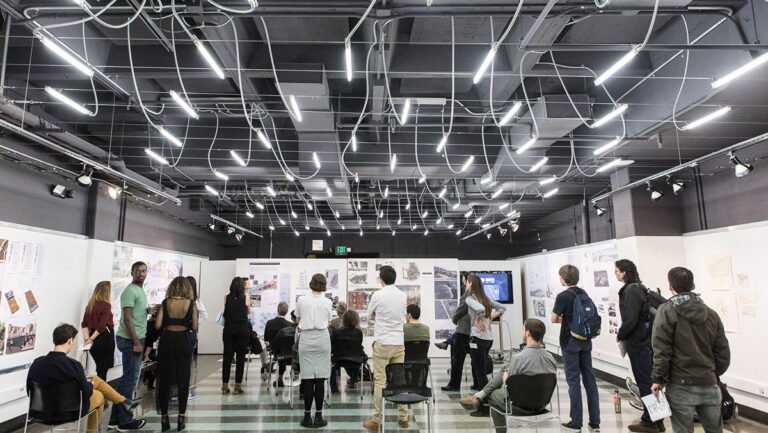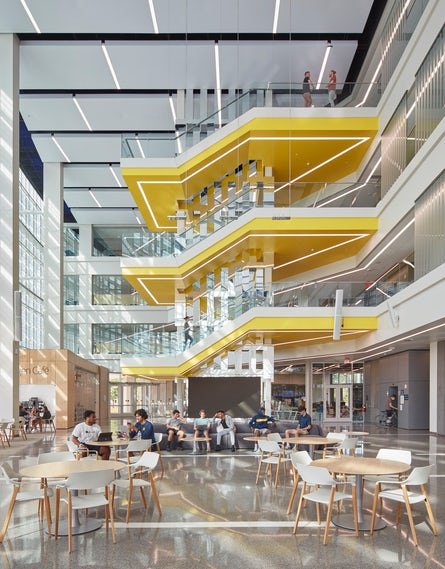AIDIA STUDIO Designs Contextual Futuristic Tulum Train Station
Tulum Train Station – We set out by asking ourselves how we could best fit a train station in the jungle, making it belong in its context while marking an entry point to the beach resort of Tulum. Our first intuition was to limit the footprint of the building as much as possible to minimize the amount of jungle impacted, we achieved that by stacking the program vertically, thinning the ends and thickening the center where the bulk of the functions converge. A perforated grid shell roof crowns the station letting light through from the top and air from the sides to assist passive cooling and ventilation.
Architizer chatted with Rolando Rodriguez-Leal and Natalia Wrzask from AIDIA STUDIO, to learn more about this project.
Architizer: What inspired the initial concept for your design?
Rolando Rodriguez-Leal & Natalia Wrzask: Pre-Hispanic architecture is defined by its monumentality, its symmetry, and its precise placement in relation to seasonal solar events such as the equinoxes and the solstices. In addition, cities, and temples around Mesoamerica feature very strong composition principles in their layouts and great artistic, religious, and literary references through wall carving, painting, and engraving. As such, we set on a journey aiming to honor some of these traits and reinterpreting them into a contemporary architecture.

© AIDIA STUDIO

© AIDIA STUDIO
What do you believe is the most unique or ‘standout’ component of the project?
Its sweeping roof structure along with the parametric geometrical patterns and the play of lights and shadows that it creates within the station.

© AIDIA STUDIO

© AIDIA STUDIO
What was the greatest design challenge you faced during the project, and how did you navigate it?
The engineering of the roof without a doubt. Initially we went through multiple options to get the right shape, aiming for a natural sweep with a balanced rise and an effortless grounding. In addition, throughout the design development phase, we iterated its tessellation and the structural solution tens of times until we reached an optimum balance between the weight of the structure and the fabrication sizes for the UHPFRC panels. Ultimately this whole process was assisted by the use of parametric design and coding, making the iteration process faster and more efficient.

© AIDIA STUDIO

© AIDIA STUDIO

© AIDIA STUDIO

© AIDIA STUDIO
How did the context of your project — environmental, social or cultural — influence your design?
Despite its futuristic appearance, the project itself is 100% contextual. Environmentally by limiting the amount of land taken, along with passive design strategies for lighting, cooling and ventilation. Culturally by reinterpreting some of the key features seen in Mayan architecture and Socially by thinking of the station beyond its functional needs and perceiving it as a meeting point for locals, visitors and staff.

© AIDIA STUDIO

© AIDIA STUDIO
What drove the selection of materials used in the project?
The Yucatan peninsula’s bedrock is limestone, below it a complex hydrological system of underground sweet water rivers, the longest in the world gives life to one of the most diverse ecosystems on earth. This karstic bedrock is pierced by erosion every so often creating craters onto these rivers called cenotes. The Mayan culture built their temples on top of them as they perceived them as sacred omens.
This background made it very clear that we wanted limestone as the cladding material for the envelope of the building. In addition we rescued a millenary tradition of resin-based stucco used anciently by the Mayans called “chukum” after the tree of the same name. The mixture is highly resistant to flexion and lets little humidity in, we chose this ancient technique for the plastering of interior walls and ceilings.

© AIDIA STUDIO

© AIDIA STUDIO
What is your favorite detail in the project and why?
The way the light filters down from through the roof into the main hall and down into the platforms. The perception of the space is constantly changing as the patterns on the floor create a kinetic dance of light and shadow.

© AIDIA STUDIO
How important was sustainability as a design criteria as you worked on this project?
Sustainability was at the center of the design process from beginning to end; as a practice we are fully committed to a biophilic design agenda where nature feeds and inspires the way we craft our architecture. Sustainability reaches further than a specific strategy to make the building perform in a greener way, in our process, it is enriched by the specificity of its context either cultural, social or economic and our aim is to enrich the way our buildings look, feel and perform.

© AIDIA STUDIO
In what ways did you collaborate with others, and how did that add value to the project?
Architectural design is a multi-sided stream of ideas, constraints, variables, and engineering angles. The role of the architect is to guide the process and let the project be nourished and fed by multiple parties while preserving and safeguarding the essence of the conceptual underpinning.

© AIDIA STUDIO
What key lesson did you learn in the process of conceiving the project?
Every project is different but the commitment and effort to make it a success never changes.
How do you believe this project represents you or your firm as a whole?
Our Tulum Train Station amalgamates a number of principles that have defined us from the outset. It features a solid sustainability strategy and underpinning, it incorporates complex geometrical solutions and most importantly it created a unique differentiated experience by letting light and shadow play and move along the space.

© AIDIA STUDIO
How do you imagine this project influencing your work in the future?
It has been a massive referent and has helped cement our reputation as an emerging architectural practice.
Team Members
Lead Architects: Rolando Rodriguez Leal, Natalia Wrzask
For more on Tulum Train Station, please visit the in-depth project page on Architizer.
Tulum Train Station Gallery


